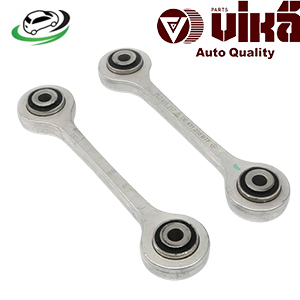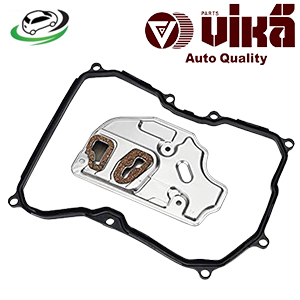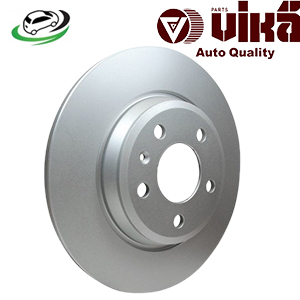-13%
Get Rear Brake Disc AUDI A4/A5/A6/A7/Q5 8K0615601B
The brake disc, also known as a rotor, is a crucial component of a vehicle’s braking system. It works in tandem with the brake pads and calipers to bring the vehicle to a stop. Understanding the brake disc’s function, benefits, common issues, and maintenance practices is essential for ensuring safe and efficient braking performance.
What is a Brake Disc?
A brake disc is a flat, circular component made of cast iron or composite materials, such as carbon or ceramic composites. It is attached to the wheel hub and rotates with the wheel. When the brake pedal is pressed, the brake pads are squeezed against the brake disc by the caliper, creating friction that slows down and eventually stops the wheel’s rotation.
How Does a Brake Disc Work?
The brake disc operates through a series of interactions with other braking components:
- Brake Calipers and Pads: When the driver presses the brake pedal, hydraulic fluid is sent to the brake calipers. The calipers then press the brake pads against both sides of the brake disc, creating friction.
- Heat Dissipation: The friction generated during braking converts kinetic energy into heat. The brake disc is designed to dissipate this heat efficiently to prevent overheating and maintain braking performance.
- Stopping the Vehicle: The friction between the brake pads and the disc slows the rotation of the wheel, bringing the vehicle to a stop. The effectiveness of this process depends on the condition of the brake disc and pads.
Types of Brake Discs
There are several types of brake discs, each offering different advantages:
- Solid Discs: These are basic brake discs without any internal ventilation. They are typically used in smaller or less powerful vehicles.
- Vented Discs: These discs have a series of vanes between the two faces of the disc, allowing for better heat dissipation. They are commonly used in modern vehicles for enhanced performance.
- Drilled and Slotted Discs: These discs have holes (drilled) or grooves (slotted) on their surface to improve heat dissipation, reduce brake fade, and remove debris from the braking surface. They are often used in high-performance and racing applications.
- Carbon-Ceramic Discs: Made from composite materials, these discs offer superior performance, durability, and heat resistance. They are typically found in high-end sports cars and racing vehicles.
Benefits of a Properly Functioning Brake Disc
A well-maintained brake disc provides numerous benefits for vehicle performance and safety:
- Effective Braking: Properly functioning brake discs ensure efficient braking performance, allowing the vehicle to stop quickly and safely.
- Heat Management: Good quality brake discs can effectively dissipate heat, preventing brake fade and maintaining consistent braking performance.
- Longevity: High-quality brake discs are durable and can withstand the stresses of repeated braking, providing long-term reliability.
- Safety: Reliable brake discs are crucial for the overall safety of the vehicle, ensuring that the driver can stop the vehicle effectively in emergency situations.
Common Issues with Brake Discs
Brake discs can develop several issues over time due to wear and tear, environmental factors, and driving habits. Common problems include:
- Warping: Excessive heat or improper installation can cause the brake disc to warp, leading to vibration and reduced braking performance.
- Cracking: Repeated heating and cooling cycles, especially in high-performance or heavy-duty applications, can cause cracks in the brake disc.
- Scoring and Grooving: Debris, worn brake pads, or metal-to-metal contact can cause scoring and grooving on the surface of the brake disc, reducing its effectiveness.
- Corrosion: Exposure to moisture, road salt, and other environmental factors can cause corrosion, leading to pitting and reduced structural integrity of the brake disc.
- Uneven Wear: Misaligned calipers or other issues can cause uneven wear on the brake disc, affecting braking performance and causing noise or vibration.
Signs of Failing Brake Discs
Identifying the signs of failing brake discs can help address issues before they lead to more severe problems. Common symptoms include:
- Vibration: A vibrating brake pedal or steering wheel during braking can indicate warped brake discs.
- Squealing or Grinding Noises: Unusual noises during braking can indicate worn brake pads or damaged brake discs.
- Reduced Braking Performance: Increased stopping distances or a spongy brake pedal can indicate issues with the brake discs or other braking components.
- Visual Damage: Visible cracks, grooves, or uneven wear on the brake disc surface can indicate the need for replacement.
Maintenance and Replacement
Regular maintenance and timely replacement of brake discs are essential for ensuring reliable braking performance and safety. Here are some maintenance tips:
- Regular Inspections: Periodically inspect the brake discs and related components for signs of wear, damage, or corrosion. Regular maintenance can help identify issues early and prevent more severe problems.
- Replace Worn Pads: Replace brake pads before they become excessively worn to prevent damage to the brake discs.
- Proper Installation: Ensure that brake discs are installed correctly, following the manufacturer’s specifications and using appropriate tools and techniques.
- Avoid Overheating: Avoid driving habits that cause excessive heat buildup, such as riding the brakes or repeated hard braking.
- Use High-Quality Parts: When replacing brake discs, use high-quality parts that meet or exceed the manufacturer’s specifications to ensure durability and performance.
Replacement Procedure
Replacing brake discs typically involves the following steps:
- Preparation: Ensure the vehicle is on a level surface and secure it with jack stands if necessary. Gather the necessary tools and replacement brake discs.
- Remove the Wheel: Remove the wheel to access the brake disc and caliper assembly.
- Remove the Caliper: Use the appropriate tools to remove the caliper and secure it with a hanger or support to prevent strain on the brake hose.
- Remove the Old Disc: Remove any retaining screws or fasteners and carefully remove the old brake disc from the wheel hub.
- Install the New Disc: Clean the hub surface and position the new brake disc in place. Secure it with any retaining screws or fasteners.
- Reinstall the Caliper: Reinstall the brake caliper, ensuring that the brake pads are properly aligned and secured.
- Check for Proper Operation: After reassembly, check for proper operation of the brakes. Pump the brake pedal to ensure that the caliper pistons are properly seated.
- Test Drive: Take the vehicle for a test drive to ensure that the new brake discs and braking system are functioning correctly and that there are no issues with noise, vibration, or braking performance.
Follow us on Facebook for more parts.



